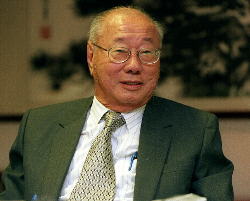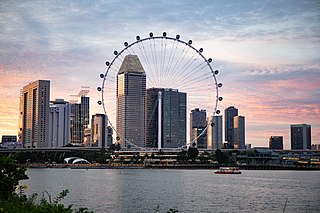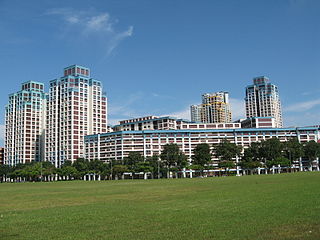
Ang Mo Kio is a planning area and residential town situated in the North-East region of Singapore. Located approximately 11 km (6.8 mi) north of the Downtown Core district, Ang Mo Kio is the 3rd most populated planning area in the North-East region and ranks 8th in terms of population in the country overall. The planning area is located at the south-western corner of the North-East region, bordered by the planning areas of Yishun to the north, Sengkang to the north-east, Serangoon to the east, Bishan to the south and the Central Water Catchment to the west.

The Housing & Development Board, is a statutory board under the Ministry of National Development responsible for the public housing in Singapore. Established in 1960 as a result of efforts in the late 1950s to set up an authority to take over the Singapore Improvement Trust's (SIT) public housing responsibilities, the HDB focused on the construction of emergency housing and the resettlement of kampong residents into public housing in the first few years of its existence.

Pasir Ris is a planning area and residential town located in the East Region of Singapore. It is bordered by Tampines and Paya Lebar to the south, Sengkang to the southwest and Changi to the east. The planning area also shares riverine boundary with Punggol to the west, separated by the Serangoon River, as well as having a maritime boundary with the North-Eastern Islands planning area, across the Straits of Johor.

MacPherson is a neighbourhood located within the district of Geylang in the Central Region of Singapore. Its location roughly corresponds to the identically titled subzone in the Geylang Planning Area and is approximately sandwiched between the neighbourhoods of Aljunied and Paya Lebar. MacPherson largely consists of various public housing estates centered on Circuit Road and an industrial area. The Pelton Canal runs through the neighbourhood, which separates a private housing estate off MacPherson Road, and the public housing estate along Circuit Road.

Bukit Panjang is a planning area and residential town located in the West Region of Singapore. A portion of this town is situated on a low-lying elongated hill. The planning area is bounded by Bukit Batok to the west, Choa Chu Kang to the northwest, Sungei Kadut to the north, the Central Water Catchment to the east and Bukit Timah to the south. Bukit Panjang New Town is located at the northern portion of the planning area. Bukit Panjang has an average elevation of 36m/118 ft.

Queenstown is a planning area and satellite residential town situated on the south-westernmost fringe of the Central Region of Singapore. It borders Bukit Timah to the north, Tanglin to the northeast, Bukit Merah to the east and southeast, as well as Clementi to the northwest and west. Its southern and southwesternmost limits are bounded by the Pandan Strait.
Tiong Bahru is a housing estate located within the Bukit Merah Planning Area, in the Central Region of Singapore. Tiong Bahru was constructed in the 1920s by the Singapore Improvement Trust, the predecessor to the Housing Development Board (HDB) and an entity of the British colonial authority providing mass public housing in Singapore and is the oldest housing estate in Singapore. The main estate consists of 30 apartment blocks with over 900 units of two to five rooms that are also commonly referred to as "walk-ups". There are also high-rise HDB flats and condominiums along Boon Tiong Road, Jalan Membina and Kim Tian Road which surround the main estate.

The Selective En bloc Redevelopment Scheme, or SERS for short, is an urban redevelopment strategy employed by the Housing and Development Board in Singapore in maintaining and upgrading public housing flats in older estates in the city-state. Launched in August 1995, it involves a small selection of specific flats in older estates which undergo demolition and redevelopment to optimise land use, as opposed to upgrading of existing flats via the Main Upgrading and Interim Upgrading Programmes. To date, 82 SERS sites have been announced, of which 77 were completed. The implementation of SERS also depends on the availability of replacement sites and the Government's financial resources. It will be replaced by Voluntary Early Redevelopment Scheme (VERS) in 20 years time.
The Main Upgrading Programme, or MUP, was formally launched as the Singapore government’s pioneer housing upgrading programme in 1992, by then Prime Minister Mr Goh Chok Tong. Under the MUP, residents enjoyed an improved living environment without the need to move out from their familiar surroundings. The MUP has been brought to 128 precincts island-wide, benefitting 131,000 households.

Lim Kim San was a Singaporean businessman, civil servant, and politician who served as a Cabinet minister with a variety of portfolios between 1965 and 1981. Prior to his tenure as a member of parliament, Lim was appointed chairman of Singapore's newly created Housing & Development Board (HDB), and he would go on to be recognized for the HDB's success in its resolution of Singapore's housing shortage.

Boon Lay is a neighbourhood located in the town of Jurong West in the West Region of Singapore. Its borders very roughly correspond to the URA subzone of Boon Lay Place, situated within the Jurong West Planning Area.

The Singapore Improvement Trust (SIT) is a former government organisation that was responsible for urban planning and urban renewal in Singapore. Formally established in 1927 under the Singapore Improvement Ordinance, it was modelled after similar organisations in India. The SIT initially carried out back lane improvement schemes and marking out unsanitary buildings for demolition, but began constructing public housing from 1935. After 1945, the SIT initially focused its efforts on the repair of its residential developments. It resumed constructing public housing in 1947 but was unable to keep up with demand. The SIT was also involved in the development of a "Master Plan", which set out Singapore's developmental direction, from 1952 to 1958. In the late 1950s, plans were set out to replace the SIT with two departments—housing and planning—culminating in two bills that were passed in 1959. With the establishment of the successor organisations by the government of Singapore, the Housing and Development Authority and the Planning Authority, in 1960, the SIT was dissolved.

Lift Upgrading Programme (LUP) is a Singapore Housing and Development Board (HDB) project which upgrades and improves the facilities of the lifts at HDB flats. This project is for housing blocks built before the year 1996, which were built with lifts that only serve some floors to meet privacy demands and to cut costs. A poll with a 75% majority in favor is needed for the upgrading to begin. The non-citizen residents who stay in the same HDB block have no polling rights.

This article shows the notable future developments in Singapore. Most of them are currently under construction with most to be completed within the next five years.

Public housing in Singapore is subsidised, built and managed by the Government of Singapore thorugh the Housing and Development Board (HDB). The majority of the residential housing developments in Singapore are publicly governed and developed, and home to approximately 80% of the resident population. These flats are located in housing estates, which are self-contained satellite towns with well-maintained schools, supermarkets, malls, community hospitals, clinics, hawker centres and sports and recreational facilities. Every housing estate includes Mass Rapid Transit (MRT) stations and bus stops that link residents to other parts of the city-state. Some estates are also complemented by smaller LRT stations which act as a feeder service to the MRT.
The Home Improvement Programme (HIP) is a programme announced by HDB, during the National Day Rally in August 2007 that replaced the Main Upgrading Programme (MUP). The HIP offers lessees a choice on the works they want to be included in the upgrading of their flats. It also helps lessees deal with common maintenance problems in ageing flats, such as spalling concrete and ceiling leaks, in a systematic and comprehensive manner. Flats are eligible for HIP twice, one at 30 years old and one at 60–70 years old. The HIP is targeted at flats built til 1997. Priority of upgrading programmes is traditionally given to wards held by the ruling People's Action Party, which appoints the Minister for National Development who oversees the Housing Development Board. When asked why opposition wards are penalised by the statutory board at a NUS student forum in 2011, Prime Minister Lee Hsien Loong responded, "The answer is that there has to be a distinction. Because the PAP wards supported the Government and the policies which delivered these good things.”

The new towns of Singapore are planned communities located across Singapore that are designed to be self contained. Designed to house up to 300,000 residents, these new towns contain areas zoned for housing, recreation and employment, and are composed of multiple neighbourhoods, each of which is further subdivided into multiple precincts. Amenities in these new towns are provided through a multi-tiered system, and based on Housing and Development Board (HDB) guidelines. As of 2022, the country has 24 new towns.
Dakota Crescent is one of Singapore’s oldest housing estates built by Singapore Improvement Trust (SIT), the government development authority, in 1958.

In Singapore, a town council (TC) is an entity formed by at least one elected Member of Parliament (MP) and appointed residents who are responsible for the day-to-day operations in managing the common property of the Housing and Development Board (HDB) residential flats and commercial property within the town. The sizes and structure of a town council can be changed due to political electoral changes. It is often considered a very limited form of local government that are strictly limited to estate management, and where their members have no separation of powers from the national government. As of November 2020, there are 17 town councils operating in Singapore.
Selegie House is a public housing complex which includes blocks 8-10 along Selegie Road in Singapore.















